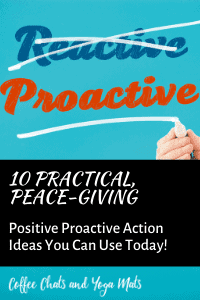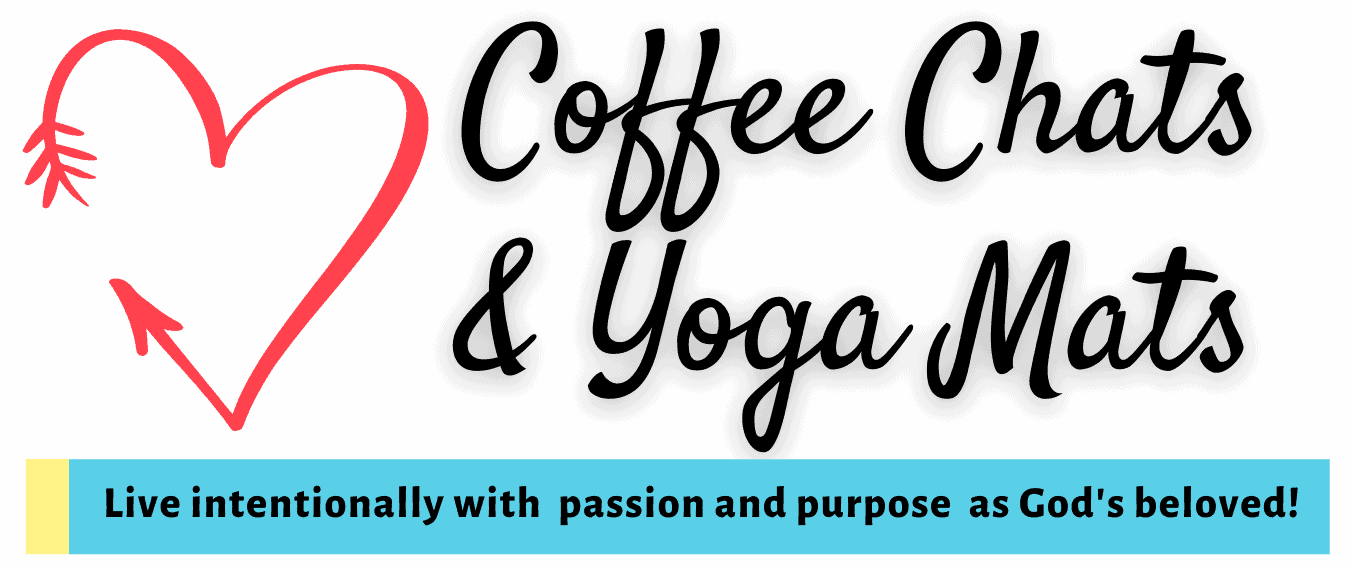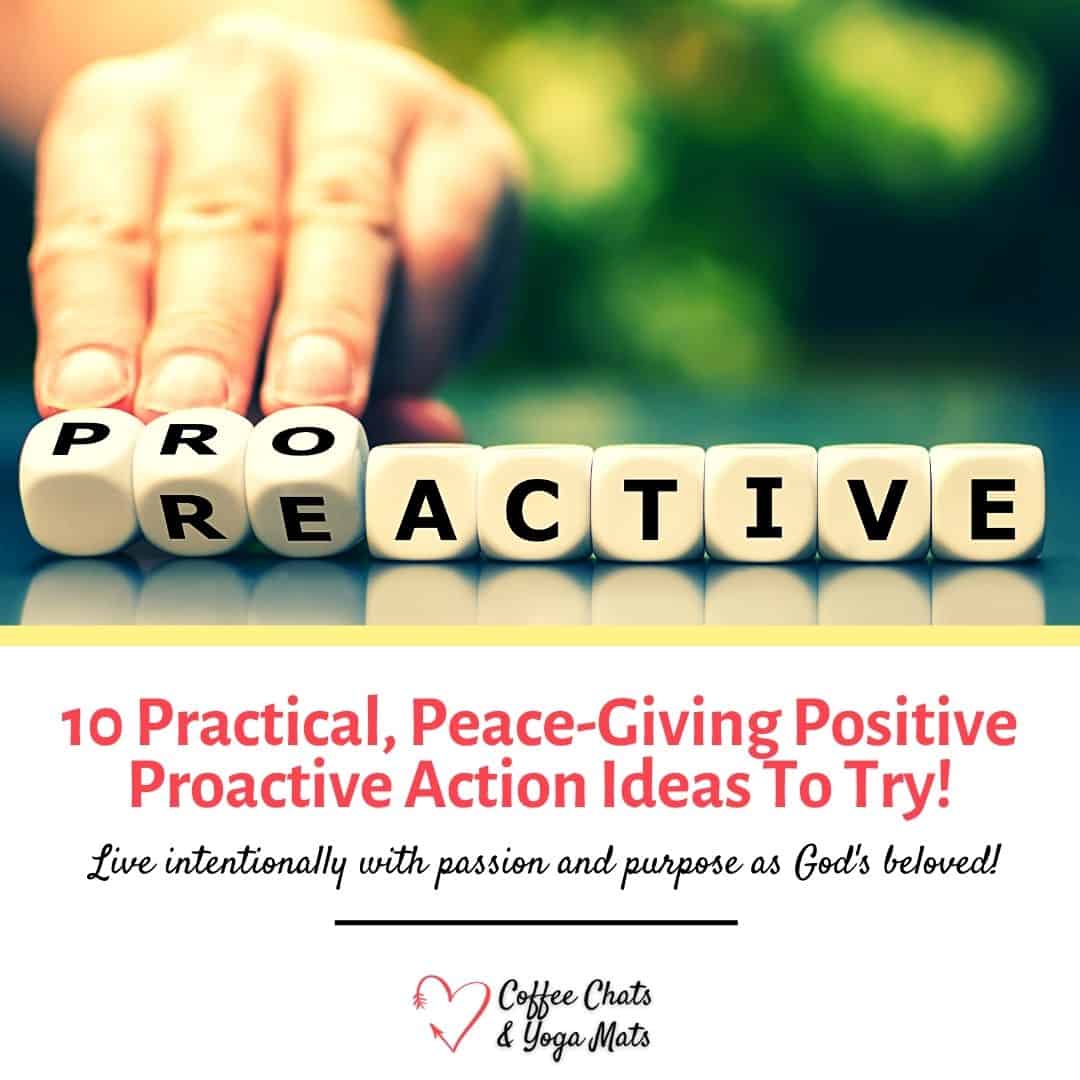10 Practical, Peace-Giving Positive Proactive Action Ideas You Can Use Today!
Back, in grad school, I decided to train for a marathon, mostly because I wanted to be a person who completed marathons. (You feel me?) On one particularly beautiful weekend, I went for a long jog around the town. Several miles and two hours later, I realized that jogging was not my jam.
Do you want to know why?
As I jogged around neighborhoods, up hills, and through the park, I kept repeating the same thought over and over again – with no internal resolution or progress.
Eventually, I realized I needed to shift gears! This was ridiculous! I needed to take positive proactive action. And I needed to do it NOW.
(Unfortunately, back then, I didn’t have that empowering term in my back pocket. Sigh).
And that, my friend, is what we’re talking about today.
You can live intentionally with passion and purpose as God’s beloved.
Here are some concrete, practical positive proactive action ideas to help you move forward – whether it be from a mind loop, well-being issue, or relationship dynamic. Let’s dive in!
- 1. Pray about it
- 2. Clarify what your core issue is (i.e. what's really bugging you?!)
- 3. Write it down – brain dump it!
- 4. Talk about it with someone who cares about your ultimate well-being
- 5. Determine what healthy boundaries need to be communicated
- 6. Communicate the boundary: Have the hard conversation
- 7. Communicate the boundary: Provide it in writing
- 8. Get rid of the dang thing
- 9. Do one small thing
- 10. Tend to your body
- Articles related to taking practical positive proactive action ideas
- Wrapping up the list of practical positive proactive action ideas
1. Pray about it
Okay, for my fellow Christ followers, this is probably ridiculously obvious.
But, dude, do you do it? Seriously, when you’re on that thought loop or raging about that issue, do you pray first?
If God created the universe, he can certainly handle your problem. As the song goes, He is for you, not against you.
So, sweet friend, let’s develop that prayer muscle of turning to Him when we’re turned inside out.
Heck, pray right now!
God, I want to learn to turn to You in all things and trust You with all things, including situations that are driving me crazy. Holy Spirit, please nudge me to turn to You and trust You when I’m trying to do it on my own. You’re everything I need. Help me remember this!
Use this simple prayer to get going!
2. Clarify what your core issue is (i.e. what’s really bugging you?!)
Of course, I want everyone to do exactly what I think is best because I have the best ideas ever.
You too?
How’s that working out for you?
It’s important to clarify what is the core issue. What’s really bothering you? What would help?
Declaring that “life would be so much better if this person would just X” isn’t a real solution.
You don’t get to decide what others do, think, or feel.
You do get to decide what YOU do, reframe how you think, and start fostering healthy feelings.

3. Write it down – brain dump it!
Dumping out what’s nagging you may help you stop obsessively overthinking. In fact, here’s some research about brain dumping and ideas to get started!
Grab a sheet of paper or open up a blank document on your computer and just dump what’s nagging you. You can trash it if you want. Just get it out of your head and in front of you.
(Personally, I’m an avid user of Evernote for this purpose. My typing fingers can often better keep up with my racing thoughts than writing them out! Note: You can use the free version until you tap out on memory capacity #myreality.)
Sometimes simply processing your thoughts (and seeing them in text) in a more concrete way can help you begin to move forward. (Here are some more tools and ideas to help you get started with journaling for healing.)
When Life is Hard, Make a List may help you get started!

4. Talk about it with someone who cares about your ultimate well-being
Perhaps tend and befriend is one of your go-to responses when you’re stressed. It should be obvious, but it’s not going to help you much if the person you go to is like:
“Those people or that thing is totally stupid! Hate ’em all!”
Remember, your goal is to take positive proactive action.
Ideally, the person or people you turn to talk it over with is:
- Is an advocate for you – they care about the impact on you – both now and in the future
- Offers grace and truth, i.e. they remind you to consider the other person’s perspective and challenge you to own your part of the problem
Here are just a couple verses about the kind of company you ought to seek out:
As iron sharpens iron, so one man sharpens another.
Proverbs 27:17 NIV
Do not be deceived: “Bad company ruins good morals.”
1 Corinthians 15:33 ESV
And – this is where it gets real – don’t just rant endlessly about the issue. (I’m totally guilty of this).
Give yourself a time limit for ranting. (It’s a start. You’re not aiming for perfection, but growth!)
Discuss and decide what next positive proactive action you need to take next so you can move forward.

5. Determine what healthy boundaries need to be communicated
Once you’ve clarified what your core issue is, you get the empowering and intimidating opportunity to clarify your boundaries.
Here’s a great definition of boundaries:
“A boundary is a limit or space between you and the other person; a clear place where you begin and the other person ends . . . The purpose of setting a healthy boundary is, of course, to protect and take good care of you”
IPFW/Parkview Student Assistance Program, PositivePsychology.com
Boundaries create an opportunity for you to more clearly honor yourself, those you’re responsible for, and those you interact with. In many ways, it’s about creating an environment that encourages healthy self-care for yourself and others.
In fact, recently, The Unfiltered Motherhood podcast had a short series focusing on boundaries! Personally, I found them very empowering to remember what boundaries are all about and healthy ways to set them. (I don’t know about you, but I totally need to give myself boundaries for screen time, etc., too!
This particular episode might give you a jumpstart: 69. Boundaries + Motherhood. The facts, the myths and why you need better boundaries ASAP with Jocelyn Hamsher
Need some boundary-setting help! Check out 10+ Excellent Resources for Setting Healthy Boundaries!

6. Communicate the boundary: Have the hard conversation
Telling someone that something is bothering you totally sucks.
Seriously. I get so intimidated by it that I’ve learned to sometimes ask someone else to speak up for me at times.

But if you handle it with grace and truth, it can be so freeing. Like mind-blowingly liberating.
We’ll most likely need to circle back to how to have hard conversations with grace and truth in a future post, but in the meantime, this Scripture is a helpful reminder of what it can begin to look like:
Everyone should look out not only for not only for his own interests, but also for the interests of others.
Philippians 2:4 HCSB
Be willing to be uncomfortable to fight for the relationship. Be kind. Be honest. Be love.
(Note: I am still learning how to navigate this with grace and truth, so I’m not an expert on HOW to do it. I just know that we NEED to do it.)
7. Communicate the boundary: Provide it in writing
Alternatively, sometimes having hard conversations are heavy with emotional weight. Sometimes sending a clear and compassionate written message is the healthier approach.
This kind of message factually and clearly states your stance, i.e. how you are choosing to navigate something or will respond. This communication should also be respectful and appreciative of the other person’s perspective and value in your life.
An advantage of communicating boundaries in written form (ideally verbal conversations have already happened!), is that it can give the other party time and space to process the boundary and can reduce confusion for the future (i.e. I thought you said X, but it was really Y).
As a reminder, positive proactive action does not mean you attack someone, guilt trip them or try to force them to think your way – this applies to written communication as well as verbal. (And again – this is a reminder to myself, too!)
Though this article doesn’t talk about how to communicate boundaries in writing, it does give some helpful guidelines for determining and communicating boundaries.
8. Get rid of the dang thing
Sometimes that nagging thing is literally a thing.
It’s that obnoxious something that glares at you in your home every time you walk by it.
You keep it out of a sense of obligation. It makes you feel like crap, but still, it sits there – reminding you of all the things you don’t like feeling.
Get rid of the dang thing! You’ve got better things to do than feel like crap in your own space.
Is it someone else’s thing? Move it to their domain where you don’t see it. Get it out of your sight so it’s not hurting your well-being.
9. Do one small thing
Sometimes the best thing to help you move forward is doing the next right thing.
(By the way, Emily P. Freeman’s book, The Next Right Thing, is such a great tool to help you apply this concept to your life!)
Maybe you’re on a loop because of everything on your plate tomorrow. Brain dump it, baby. Get it out of your head.
Still, nagging you? Decide what you can actually do and then divvy those things up throughout the day, week, or month. (Here are some tips to get started with weekly planning and monthly planning!)
Or maybe you’re totally intimidated by how to manage your budget. Start with 5 minutes. Commit to showing up and looking at your bank account for that time. That’s it. Just show up.
Or just do one tiny, minuscule task to lighten your mental load, like empty the dishwasher or set your keys out for the next day.
You get the idea – do one small thing to move yourself forward.
10. Tend to your body
When you’re stuck, tending to your body can shift the balance in the best of ways. Healthy happy movement can be so helpful!
You could tend to your body by:
- Lie down and close your eyes. (Take a nap if that’s what your body needs!)
- Drink water
- Move! Walk, dance, jump, yoga, you name it. (Here are 9 simple ideas to get you going!)
- Make an appointment to see a doctor
- Actually, go see your doctor
- Eat yummy, nourishing food (Meal planning can help!)

Articles related to taking practical positive proactive action ideas
- How taking positive proactive action can create peace
- Start Advocating for Yourself. Be brave. Speak up in small ways.
- Try these 4 Mindset Shifts to Fight Back Black Hole Thoughts
- Ever Been Smacked in the Face With a Painful Memory?
- What Have You Accepted as Normal – that you shouldn’t?
- Why You Need Healthy Happy Movement in Your Life
Wrapping up the list of practical positive proactive action ideas
Earlier, I shared about my jogging mental loop. Eventually, I shifted gears. I grabbed my laptop and camped out at a gym and journaled my heart out. In this instance, this was the kind of positive proactive action that I needed most. Finally, my mind felt free and I was ready to move on from the situation.
(I know – not the most exciting ending, but oh-soul good!)
Since finishing the marathon, I’ve been hesitant to pick up jogging again. Rather than thinking more clearly when I jog, my mind loops endlessly. No, thank you.
Kudos to the diehard runners and joggers! I admire you!!
Though I’m not interested in jogging again, this memory has been a touchstone for how life-giving and taking positive proactive action can be in frustrating situations.
Some positive proactive action ideas you might want to try to include:
- 1. Pray about it
- 2. Clarify what your core issue is (i.e. what’s really bugging you?!)
- 3. Write it down – brain dump it!
- 4. Talk about it with someone who cares about your ultimate well-being
- 5. Determine what boundaries need to be communicated
- 6. Communicate the boundary: Have the hard conversation
- 7. Communicate the boundary: Provide it in writing
- 8. Get rid of the dang thing
- 9. Do one small thing
- 10. Tend to your body
I still struggle to remember to take positive proactive action, but when I do, it’s so peace-giving. (Dude, it took me two hours to deal with it – more than once!)
This, my friend, is what I want for you. Peace. Freedom. So, whether or not you’re a jogger, add these positive proactive action ideas to your toolkit for moving forward when you feel stuck.
You can live intentionally with passion and purpose as God’s beloved.
So, what about you? Have you used any of the positive proactive action ideas above? Did it help? What positive proactive action tactics do you use?
Let’s talk in the comments!
P.S. Want some crazy simple steps to start living intentionally? Grab the Embrace Your Potential Playbook. It’ll help you zoom in on your God-gifted personality and give you practical tips to be more intentional, passionate, and purposeful as God’s beloved so you can become the best version of yourself.

I’m Cortney, a recovering over-achiever and God’s beloved who loves helping fellow Christian women like you embrace your God-given gifts so you have the confidence to live authentically.
I’m also a full-time mama to two sweet little boys, wife to my best friend, motivational speaker, and part-time Christian life coach. Chai lattes, strong coffee, podcasts, yoga, dance, and fairy tales nourish my soul and add sweetness to life.
Discovering the joy of embracing my God-given gifts and who He created me to be was a game-changer—a journey that brought freedom, unexpected delights, and relief from guilt. Finally, I felt free to be myself and ditch the pressure of being someone I wasn’t.
Incorporating those gifts into my day—from weekly planning to deciding on commitments, nurturing my marriage, and parenting—transformed everything. Now, I can’t imagine life without the perspective of fully embracing who God created me to be. I was missing so much without it!








4 Comments